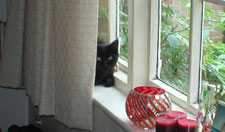Computer Science
Domain Names & IP
Unique Addresses
For the end-to-end principle to work, each machine connected to the Internet must have a unique address to identify it.
The Internet Protocol address or IP address is the mechanism for doing this. We currently are in the last days of IPv4 addresses.
IPv432 bit, 4 byte addresses.
The IP address identifies both the network and the host (the computer on the network).
For example,
192.172.0.1
Network = 192.172.0
Host = 1
The idea is to make it easier and simpler to route packets to the correct network. The router that is connected to the network can then send the packet to the correct host. IP addresses are written out in the format, 192.172.0.1
There are 4 bytes separated by full stops. Since each portion corresponds to 8 bits, the format is often know as octets. In the early days of the Internet, all addressing required IP addresses.
Domain Names
Whatever you type into your browser's address bar, the resource you request is always retrieved using its IP address. The Domain Name System was created to allow people to access resources on the Internet without having to remember the increasing number of unique IP addresses. It allows us to identify networks and hosts using memorable names.
If I type in www.multiwingspan.co.uk into the address bar of my browser,
- The browser contacts a DNS server to get the IP address.
- A DNS server would start its search for an IP address by contacting one of the root DNS servers. The root servers know the IP addresses for all of the DNS servers that handle the top-level domains (.COM, .NET, .ORG, .UK etc.).
- Your DNS server would ask the root for www.multiwingspan.co.uk, and the root, not knowing the IP address for the site, would return the IP address of the DNS server managing the .UK or .CO.UK domains.
- Your DNS server then sends a query to this server which returns the address of the name servers handling the multiwingspan.co.uk domain.
- It returns the IP address of the server holding the multiwingspan.co.uk pages and delivers the page that you requested.
Redundancy & Caching
There are lots of DNS servers at all the levels of domain. The system is fault-tolerant. It is an example of a distributed database.
DNS servers cache the IP addresses that they are asked to find. The next time it receives a request for a page on that server, it already has the information required to connect to it without contacting the root DNS servers again.
This results in an interesting phenomenon called DNS propagation. When you change the IP address that a domain points to, DNS servers that had previously cached the IP address of your domain will still be using old information. An interesting aspect of the experience of this is that, shortly after making such a change, typing in your domain may result in either of the IP addresses being returned. DNS servers do refresh their caches regularly and the system is relatively efficient. There are some sites with scripts that query DNS servers for you and show you the IP addresses they think your domain should point to. By querying a random selection of DNS servers and seeing the IP addresses returned, you can get a sense of the extent to which the changes that you have made have propagated through the DNS servers.
Top-Level Domains
The top-level domain of www.multiwingspan.co.uk is UK.
There are sveral hundred top-level domains. They include the COM, EDU, GOV, MIL domains as well as unique two-letter combinations for each country.
Second-Level Domains
The second-level domain of www.tbshs.org is TBSHS.
Every name in the top-level domain must be unique. There can be duplication across second-level domains. For example, tbshs.com, tbshs.edu et. could also be used.
Third-Level Domains
The third-level domain for www.multiwingspan.co.uk is MULTIWINGSPAN.
Third-level domains can also be duplicated. www.multiwingspan.org.uk is also permissible, for example.
There are up to 127 levels available although more than around 4 and the address ceases to be memorable and this is less likely to occur.
Host
The leftmost portion of the domain name is the host. This represents the machine on which the resource is located.
WWW refers to a web server.
Registries & Registrars
Internet Registries store the domain names that people have registered along with the IP addresses to which the pages point.
Internet Registrars are private companies that register domains to individuals and organisations.
The relative cost of owning a domain name is relatively low. Hosting companies often register them for you as part of a hosting deal. It is also possible to register a domain and have it point to free web space of the sort you tend to get with your domestic Internet connection. It currently costs around £6 to secure a domain name for 2 years.
Uniform Resource Identifier (URI)
The URI specifies how to access a resource on the Internet.
Uniform Resource Names (URN) identifies a resource by name. urn:isbn 978-0-00-724019-7
Uniform Resource Locators (URL) identify a resource by its network. http://www.multiwingspan.co.uk
URL
Starts with the protocol eg http: ftp: Then the fully qualified domain name (FQDN). www.microsoft.com. Finally the path on the addressed server /index/index.html
HOW, WHERE & WHAT

